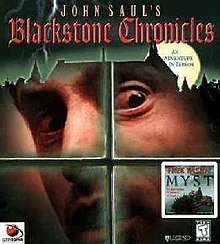John Saul's Blackstone Chronicles
John Saul's Blackstone Chronicles: An Adventure in Terror is a 1998 computer adventure game developed by Legend Entertainment and Red Orb Entertainment, and published by Mindscape.
| John Saul's Blackstone Chronicles | |
|---|---|
 | |
| Developer(s) | Legend Entertainment Red Orb Entertainment |
| Publisher(s) | Mindscape |
| Platform(s) | Microsoft Windows |
| Release | |
| Genre(s) | Adventure |
| Mode(s) | Single-player |
The game is based on serial novels that were written by John Saul, titled Blackstone Chronicles.
A sequel to the novels, the game takes place several years after the sixth book, and continues the story of Oliver Metcalf, his family, and the town of Blackstone.
Plot
The game starts with Oliver arriving at the Blackstone Asylum, which has been purchased and is being turned into a Museum of Psychiatric History. That doesn't sit well with Malcolm Metcalf, Oliver's father and last superintendent of the Asylum, who died some forty years before. All of the activity involved in transforming the Asylum has awakened its residents. For reasons not yet known to Oliver or the player, his father's spirit has taken his son, Joshua, and hidden him somewhere in the Asylum, apparently to coerce Oliver there.
Exploring the mansion, Oliver encounters several spirits of patients who are bound to the asylum by their possessions, including a teenage girl with hysterical pregnancy, a schizophrenic who believes she's English royalty, and a depressed woman who was treated with steam baths and hydrotherapy. Oliver discovers that his father psychologically tortured to suicide or allowed several of his patients to be killed under the guise of accidents during treatment. This is counterpointed by the sterile and rose-tinted explanations from the museum equipment for the same procedures or implements (lancets are described as an attempt to bring the bodies humours into balance, where the spirit of a patient with Alzheimer's disease declares they were used liberally so patients could not defend themselves). Disheartened by the failure of traditional medicine, Oliver's father gradually turned to more and more extreme methods, including totally dismembering and vivisecting an 8-year-old boy to cure his illness. Eventually his treatments turned to outright torture, as a punishment of undesirable behaviors to eventually remove them.
Over the course of the game, Oliver collects several personal items that influence him, causing him to nearly kill himself in several psychiatric methods (ECT, self-injecting neuro-toxins, locking himself in a steam box). His father Malcolm implies this is caused by the inherent evil contained within the items, although its heavily implied that Oliver developed these traps himself while under Malcolm's control, through a long, complicated sequence of post-hypnotic suggestions.
Oliver's father eventually reveals his plan. While Oliver has been trapped in the asylum and continued to refuse Malcolm's demands that Oliver take vengeance on Malcolm's enemies, Malcolm returned Joshua home, and instructs him to murder his mother with a straight razor, as a punishment of Oliver for his disobedience to his father and to make Joshua a monster with Malcolm's similar outlook. With the help of the spirits trapped in the asylum, Oliver destroys the artifacts of his father throughout the asylum, banishing his fathers spirit.
Development
Production of Blackstone Chronicles' audiovisuals was outsourced to Presto Studios, creators of the Journeyman Project series.[2]
Reception
| Reception | ||||||||||||||||
|---|---|---|---|---|---|---|---|---|---|---|---|---|---|---|---|---|
| ||||||||||||||||
In Computer Gaming World, Allen Greenberg summarized, "Blackstone Chronicles is definitely a unique piece of work with a gripping storyline, wonderful graphics, and a most talented cast. It should not be missed."[3] John Altman of Computer Games Strategy Plus considered the game "recommendable, if not rave-worthy." He found the graphics middling, and felt that the game's heavy reliance on written text bogged down the experience. However, he wrote that Blackstone Chronicles has "good atmosphere, well-integrated puzzles, and the occasional truly memorable scene."[6]
Reviewing the game for PC Gamer US, T. Liam McDonald called it "the kind of narrative-driven, atmospheric adventure game we see too little of in these days of soulless Myst clones." While he disliked its visuals and lack of character interaction, he felt that Blackstone Chronicles offered "enough to recommend it to many adventure-starved gamers."[5]
Blackstone Chronicles was a finalist for Computer Gaming World's 1998 "Best Adventure" award, which ultimately went to Grim Fandango and Sanitarium (tie).[9] In 2011, Adventure Gamers named Blackstone Chronicles the 43rd-best adventure game ever released.[10]
See also
References
- Dunkin, Alan (November 13, 1998). "The Blackstone Chronicles Ships". GameSpot. Archived from the original on June 8, 2000. Retrieved December 6, 2019.
- https://web.archive.org/web/20000818122215/http://www.ga-source.com/interviews/beneath.shtml
- Greenberg, Allen (February 1, 1999). "The Blackstone Chronicles". Computer Gaming World. Archived from the original on August 16, 2000.
- Nash, Jonathan. "Ultimate". PC Gamer UK (69). Archived from the original on March 19, 2002. Retrieved February 7, 2020.
- McDonald, T. Liam (February 1999). "Blackstone Chronicles". PC Gamer US. Archived from the original on March 3, 2000.
- Altman, John (November 25, 1998). "The Blackstone Chronicles". Computer Games Strategy Plus. Archived from the original on November 6, 2004.
- Staff (March 1999). "John Saul's Blackstone Chronicles". Next Generation (51): 91.
- Houghton, Gordon (April 19, 1999). "John Saul's Blackstone Chronicles Review". PC Gaming World. Archived from the original on October 9, 1999. Retrieved February 7, 2020.
- Staff (April 1999). "Computer Gaming World's 1999 Premier Awards;CGW Presents the Best Games of 1998". Computer Gaming World (177): 90, 93, 96–105.
- AG Staff (December 30, 2011). "Top 100 All-Time Adventure Games". Adventure Gamers. Archived from the original on June 4, 2012. Retrieved February 7, 2020.